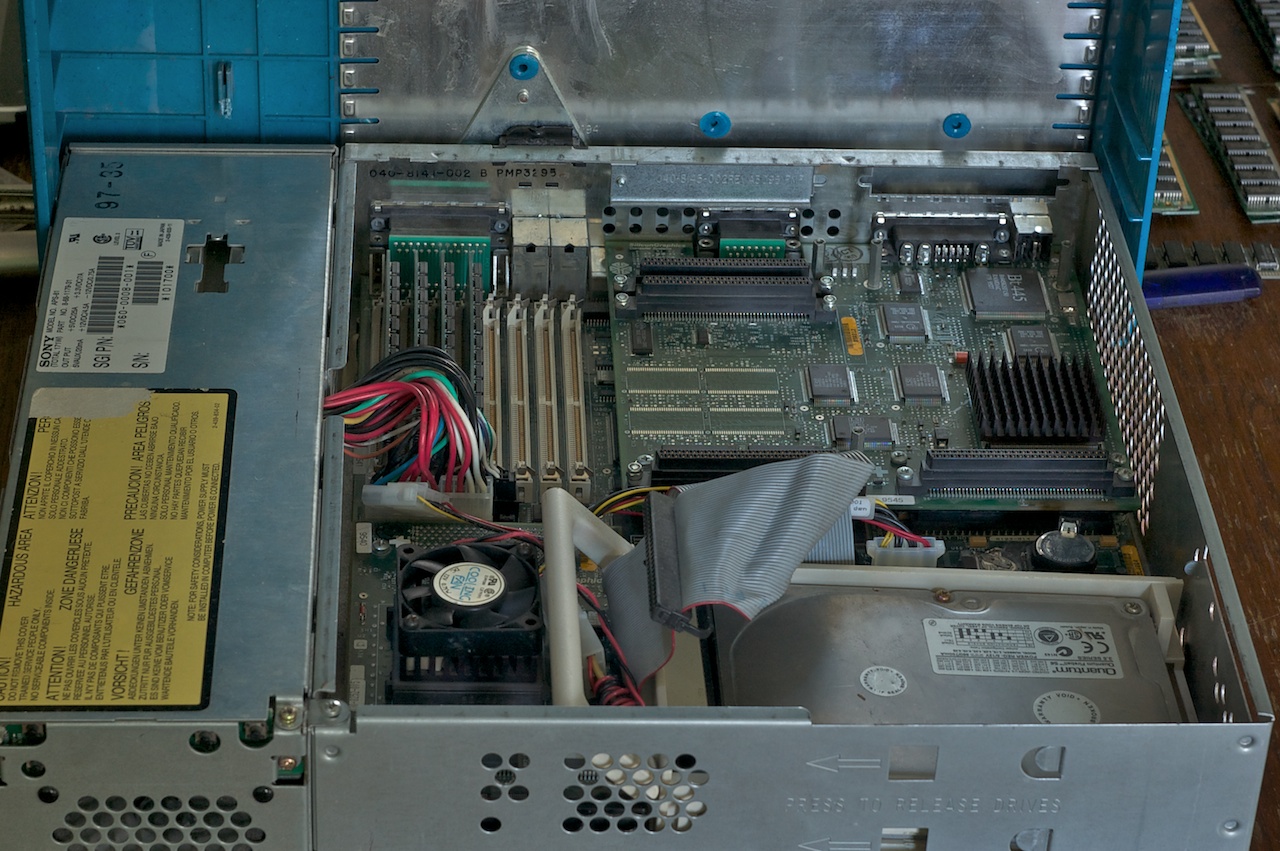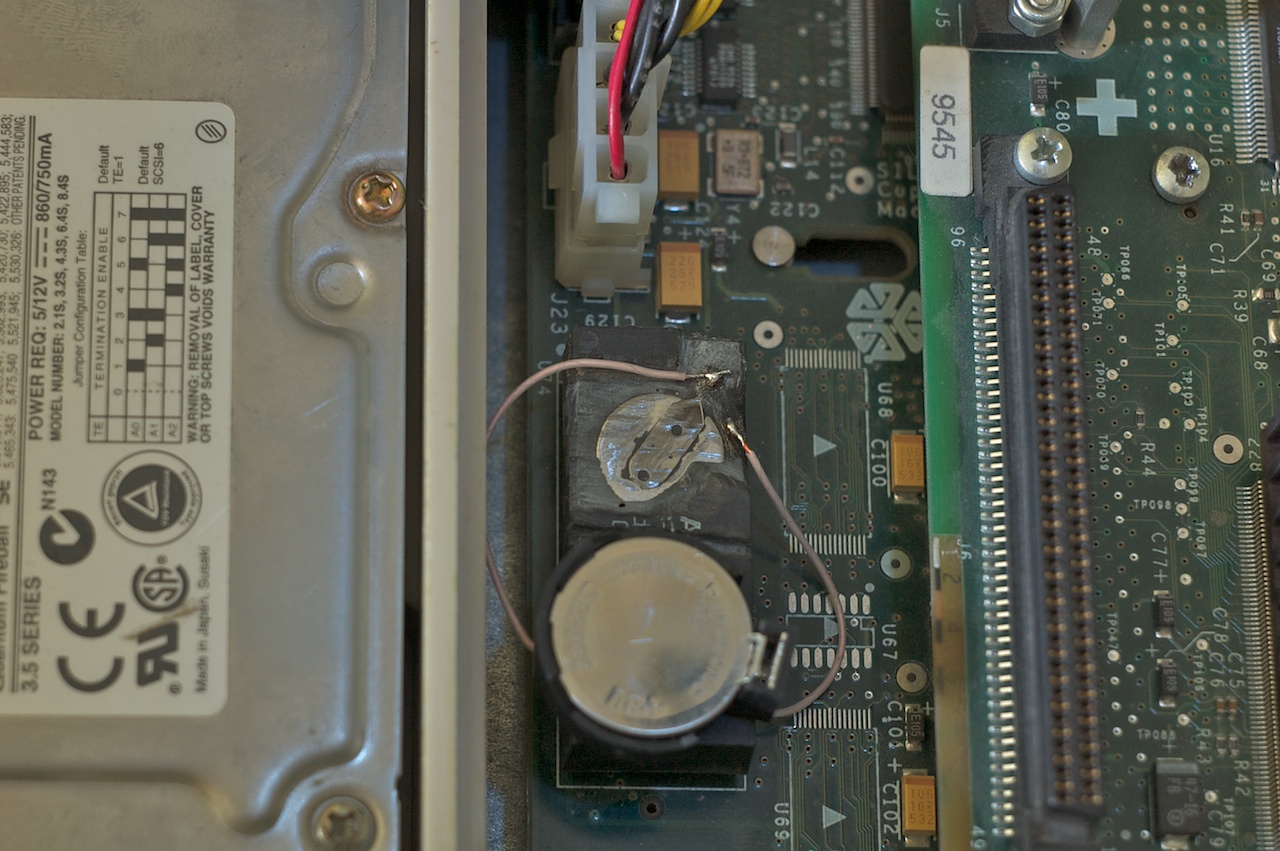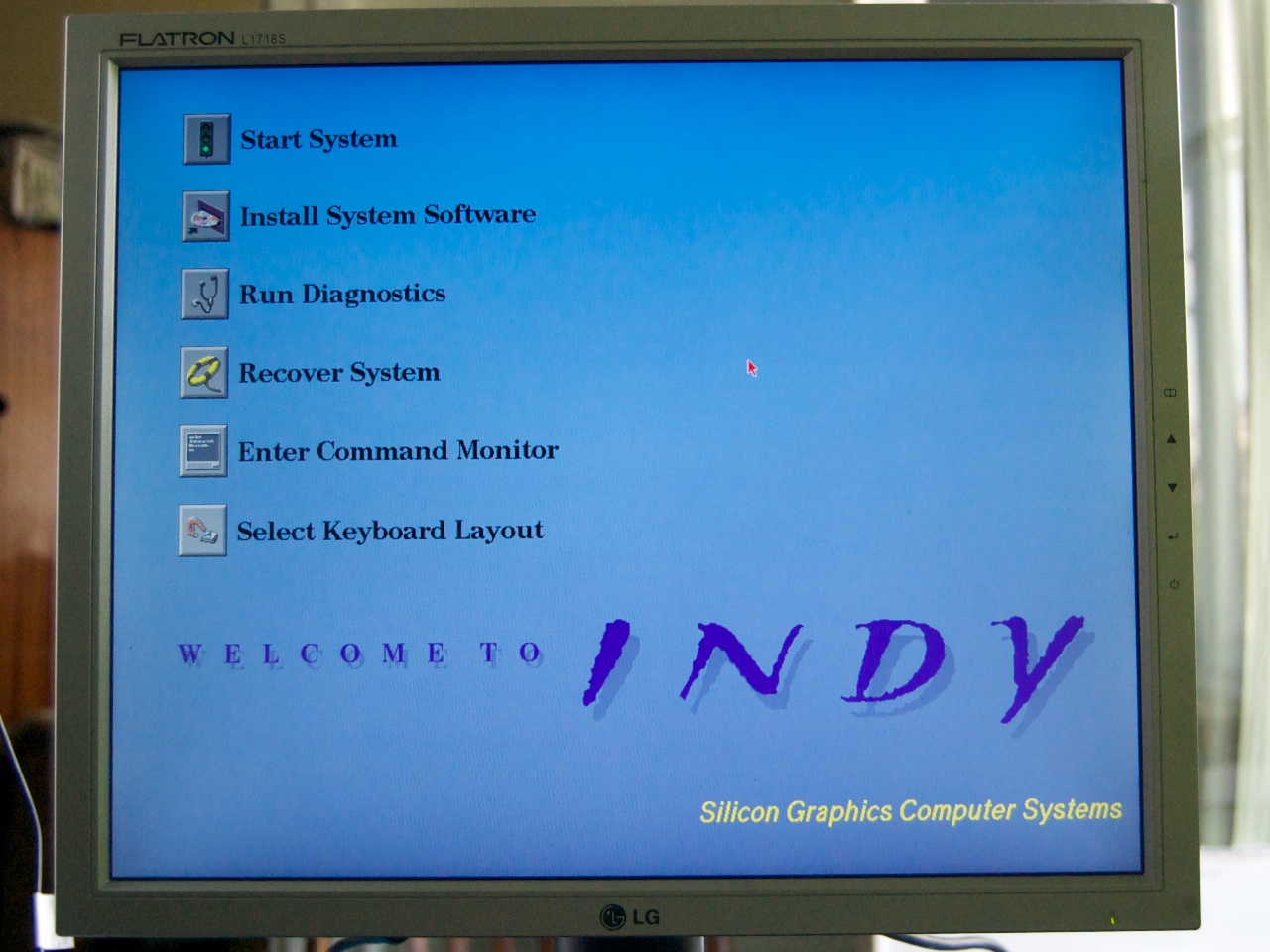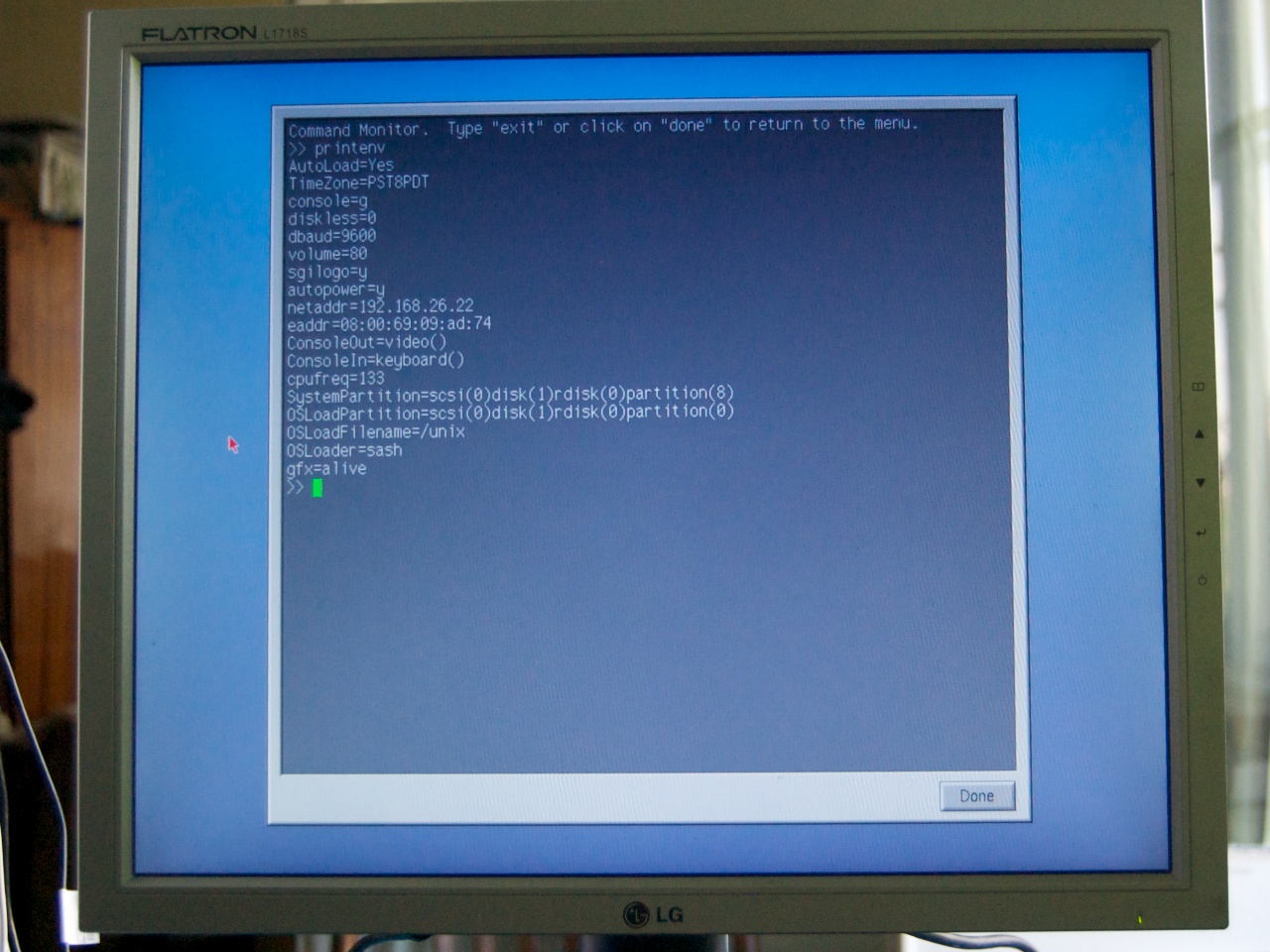Rare graphic station SGI Indy. 20 years later
The other day, I celebrated my twentieth birthday graphic graphics station Silicon dusting in my closet.
I got it in 2006, the bonus to some kind of purchase from the barges. Then I got a 8 gigabyte screw for it, put Debian MIPS and put it in the storage room as a file storage facility. And over time, the need for it has disappeared and I canned this miracle of technology until better times.
And as a holiday gift for the anniversary, it was decided to bring the computer into a historical state. Under the cut review and dramatic history of the computer, which cost in the mid-90s from $ 10,000 (which is one and a half times more expensive than the top Macintosh Quadra at that time).
')

Main characteristics:
The standard for this SCSI computer hard drive and magneto-optical drive were stolen before me along with a basket, but the eight-gig Seagate Barracuda would easily accommodate both the IRIX and a good collection of rare software (for example, Photoshop 3.0 took some 30 megabytes).
The above said that the machine has 64 megabytes of RAM accumulated by four 16 megabyte SIMM-modules. Since the memory is in a machine with double parity, I needed to find 4 more identical SIMMs to increase the memory up to 128 megabytes; This is the minimum amount of memory to run the latest Indy-supported IRIX version 6.5.22. With this quest, I could not cope. All the memory modules found were different and the car refused to turn on.
Climbing on torrent trackers, I found and downloaded (forgive me SGI inc.) For him a CD image with IRIX 5.3, for which the available memory was enough and started to restore.
First of all, we look under the hood of a personal supercomputer.

The motherboard occupies almost the entire area of the case. Next to it is Sony's 200W power supply unit with a very quiet cooler, dynamically changing speed (ATX? No, you have not heard!) . The second floor is attached to it:
Attentive readers may have noticed a battery soldered to the Dallas-hour chip. The fact is that the battery soldered into the chip is responsible for saving the parameters of the Open Firmware PROM. In Silicon Graphics, there are several dozens of parameters required to start the OC: unlike the PC CMOS, the path and file name of the bootloader, the console parameters, the IP address, and so on.
every time you boot it is quite tedious. And in order not to suffer from the selection and ordering of a similar microcircuit, I simply filed off the chip case and soldered the battery to the exposed contacts. Like this:

Close the case and launder it from the dust of centuries. By the way, the corporate blue color of plastic is in fact a very complex texture: translucent with white and violet patches. The front panel has power and reset buttons, volume buttons, and an indicator LED.
An incredible number of connectors are located behind:

From left to right: stereo glasses connector, display connector 13W3, audio connectors, video inputs, AUI Ethernet, SGI Cam, modem and 10 BaseT Ethernet, serial ports, 2 PS / 2, LPT and SCSI.
When you start Indy, as well as Macintosh, it plays a firm chord on the built-in speaker. After a few seconds, a dialog appears, calling for either to continue loading the Linux kernel, or to enter the PROM Monitor. We don’t need Linux anymore. We enter the monitor.

First click the last item (the mouse driver is already loaded). In the console, reset Debian boot parameters with the Resetenv command. Printenv shows that everything is reset.

Now you can proceed to partitioning the disk and installing IRIX. But more about that in the next post .
The materials from the nekochan.net forum helped me a lot to find out what was happening in the Silicon Graphics computers .
I got it in 2006, the bonus to some kind of purchase from the barges. Then I got a 8 gigabyte screw for it, put Debian MIPS and put it in the storage room as a file storage facility. And over time, the need for it has disappeared and I canned this miracle of technology until better times.
And as a holiday gift for the anniversary, it was decided to bring the computer into a historical state. Under the cut review and dramatic history of the computer, which cost in the mid-90s from $ 10,000 (which is one and a half times more expensive than the top Macintosh Quadra at that time).
')

Iron
Main characteristics:
- MIPS R4600 processor running at 133 MHz
- 64 MB RAM (4 x 16 EDO SIMM)
- Graphic subsystem entry level Newport XL (1280x1024x8 bits, without 3D acceleration).
The standard for this SCSI computer hard drive and magneto-optical drive were stolen before me along with a basket, but the eight-gig Seagate Barracuda would easily accommodate both the IRIX and a good collection of rare software (for example, Photoshop 3.0 took some 30 megabytes).
The above said that the machine has 64 megabytes of RAM accumulated by four 16 megabyte SIMM-modules. Since the memory is in a machine with double parity, I needed to find 4 more identical SIMMs to increase the memory up to 128 megabytes; This is the minimum amount of memory to run the latest Indy-supported IRIX version 6.5.22. With this quest, I could not cope. All the memory modules found were different and the car refused to turn on.
Climbing on torrent trackers, I found and downloaded (forgive me SGI inc.) For him a CD image with IRIX 5.3, for which the available memory was enough and started to restore.
First of all, we look under the hood of a personal supercomputer.

The motherboard occupies almost the entire area of the case. Next to it is Sony's 200W power supply unit with a very quiet cooler, dynamically changing speed (ATX? No, you have not heard!) . The second floor is attached to it:
- Processor unit at the bottom left.
- The most budget for Indy 8 bit XL video card based on the REX3 chipset. The maximum resolution of 1280x1024x8 with 76 HZ is enough to work with CAD and publishing packages. Performance in 3D graphics leaves much to be desired. At the edges of the video card, there are GIO32 bus slots in which you can install various upgrades for it (for example, hardware Jpeg and Mpeg compressors that existed at the time, or the Video Out block).
Attentive readers may have noticed a battery soldered to the Dallas-hour chip. The fact is that the battery soldered into the chip is responsible for saving the parameters of the Open Firmware PROM. In Silicon Graphics, there are several dozens of parameters required to start the OC: unlike the PC CMOS, the path and file name of the bootloader, the console parameters, the IP address, and so on.
SystemPartition=pci(0)scsi(0)disk(1)rdisk(0)partition(8)every time you boot it is quite tedious. And in order not to suffer from the selection and ordering of a similar microcircuit, I simply filed off the chip case and soldered the battery to the exposed contacts. Like this:

Close the case and launder it from the dust of centuries. By the way, the corporate blue color of plastic is in fact a very complex texture: translucent with white and violet patches. The front panel has power and reset buttons, volume buttons, and an indicator LED.
An incredible number of connectors are located behind:

From left to right: stereo glasses connector, display connector 13W3, audio connectors, video inputs, AUI Ethernet, SGI Cam, modem and 10 BaseT Ethernet, serial ports, 2 PS / 2, LPT and SCSI.
Launch
When you start Indy, as well as Macintosh, it plays a firm chord on the built-in speaker. After a few seconds, a dialog appears, calling for either to continue loading the Linux kernel, or to enter the PROM Monitor. We don’t need Linux anymore. We enter the monitor.

First click the last item (the mouse driver is already loaded). In the console, reset Debian boot parameters with the Resetenv command. Printenv shows that everything is reset.

Now you can proceed to partitioning the disk and installing IRIX. But more about that in the next post .
The materials from the nekochan.net forum helped me a lot to find out what was happening in the Silicon Graphics computers .
Source: https://habr.com/ru/post/221825/
All Articles